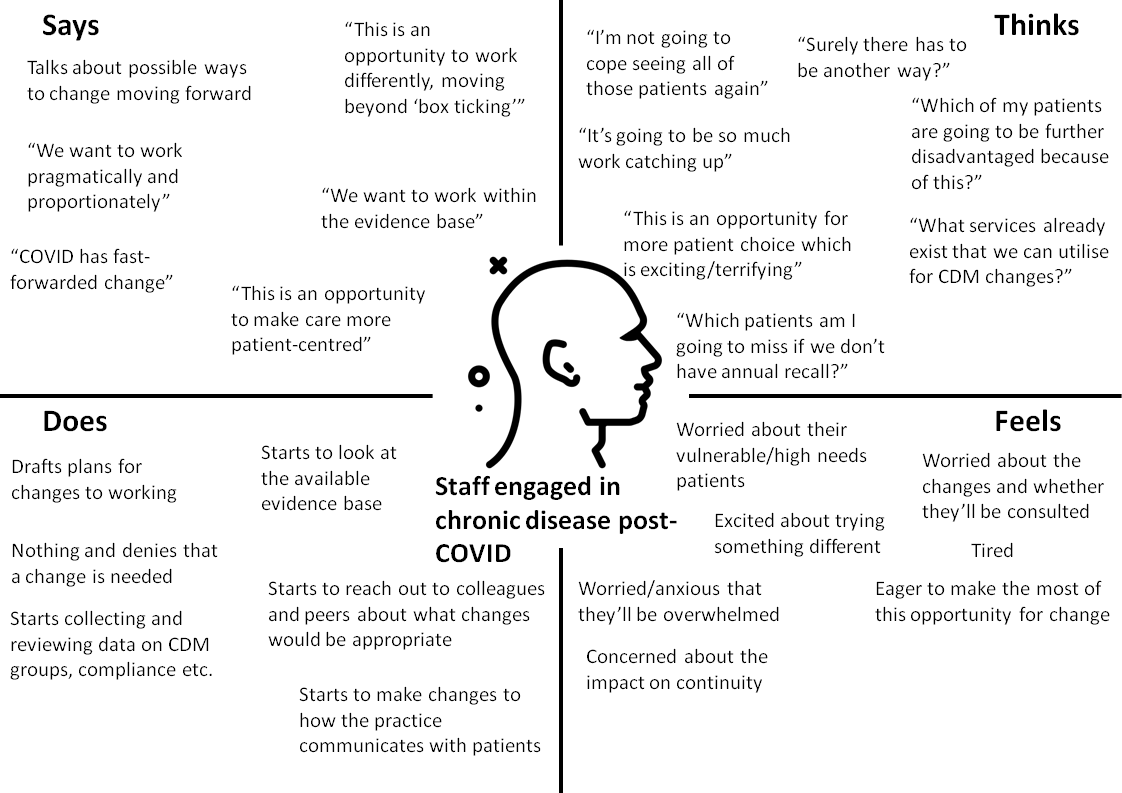Empathy Map
What is it?
Empathy maps are a tool to better understand the experiences and attitudes of another person or group (e.g. patients). It is often used to synthesise experience information that has come from the group you are mapping for.
Example empathy map
Why use it?
Empathy mapping helps to deeply understand a group of people and helps you communicate your understanding with others.
Mapping helps to identify gaps in your understanding of this group, which can help you to determine what information you require to proceed. It can also help you to determine how best to work with the group and which change ideas are likely to be most successful.
How to use it?
Pull together information you have about and from this group. It could be questionnaire responses, compliments/complaints, comments you have collected opportunistically. There is space for what you can imagine this group experiencing, however this should be implemented with caution, as assumptions may not accurately represent the group you are empathising with.
Draw/use a template (similar to shown) and place the group at the centre of the page.
Divide the information between the sections depending on your template. Templates may be broken into four sections (feels/does/thinks/says) or into up to seven sections (who/want do/see/say/do/hear/think & feel)
Who: This section allows for a brief outline of the people or group you are empathising with
What do: This section allows for an outline of what behaviour (if any) you are looking to influence or change within this group
See: This section helps to understand the messages and information that the empathised group may be exposed to. This may give insight into why some beliefs are held or why behaviours present.
Say: This section contains what a person from the group has said, such as responses from a questionnaire or a compliment form. It includes the direct quotes that you have available.
Do: This section notes the behaviour of the group during the situation. This can include behaviours resulting from feelings or thoughts about the experience (e.g. Patient waits to phone practice after lunchtime as they think the practice will be quieter)
Hear: Similar to see, this section provides broader context for the experience of the person/group we are empathising with. Consider the messages and information the people within the group hear and are exposed to.
Think: This section includes what the person has thought throughout the experience. There can be duplication between the ‘Says’ and ‘Thinks’ sections. This section will also include things that a person may not say out loud or are unwilling to share.
Feels: The section notes the feelings of the group during the section. Some templates break this down further into ‘pains’ (negative feelings) and ‘gains’ (positive feelings including understanding their wants)
Empathy maps should be created in a group. The discussion and sharing is as much an important outcome as the map itself. This can be an opportunity for broadening understanding about particular groups, as well as the potential to break down unhelpful understandings or perceptions of different groups.
More information
XPLANE – click for further information and an updated template.
Alzheimers UK - click for further information and a step-by-step guide for creating an empathy map.

